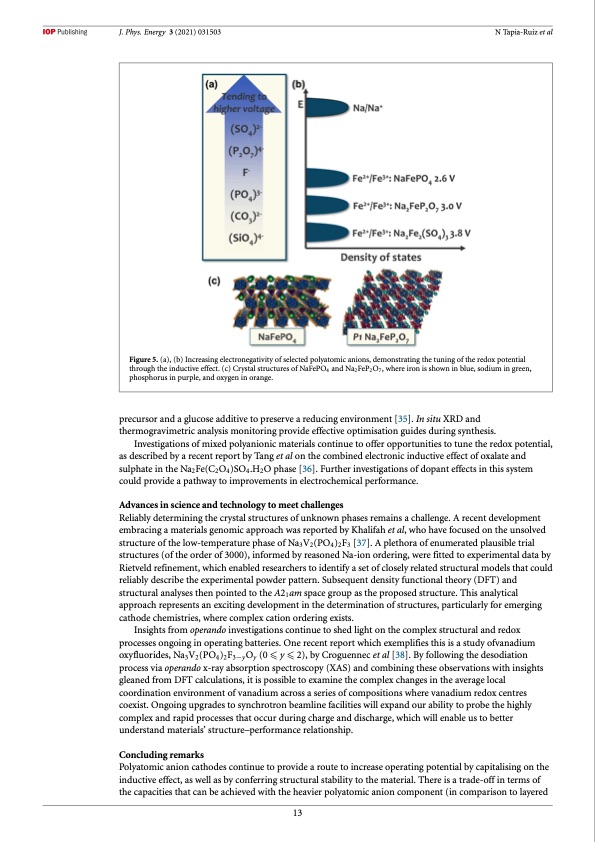
PDF Publication Title:
Text from PDF Page: 014
J. Phys. Energy 3 (2021) 031503 N Tapia-Ruiz et al Figure 5. (a), (b) Increasing electronegativity of selected polyatomic anions, demonstrating the tuning of the redox potential through the inductive effect. (c) Crystal structures of NaFePO4 and Na2FeP2O7, where iron is shown in blue, sodium in green, phosphorus in purple, and oxygen in orange. precursor and a glucose additive to preserve a reducing environment [35]. In situ XRD and thermogravimetric analysis monitoring provide effective optimisation guides during synthesis. Investigations of mixed polyanionic materials continue to offer opportunities to tune the redox potential, as described by a recent report by Tang et al on the combined electronic inductive effect of oxalate and sulphate in the Na2Fe(C2O4)SO4.H2O phase [36]. Further investigations of dopant effects in this system could provide a pathway to improvements in electrochemical performance. Advances in science and technology to meet challenges Reliably determining the crystal structures of unknown phases remains a challenge. A recent development embracing a materials genomic approach was reported by Khalifah et al, who have focused on the unsolved structure of the low-temperature phase of Na3V2(PO4)2F3 [37]. A plethora of enumerated plausible trial structures (of the order of 3000), informed by reasoned Na-ion ordering, were fitted to experimental data by Rietveld refinement, which enabled researchers to identify a set of closely related structural models that could reliably describe the experimental powder pattern. Subsequent density functional theory (DFT) and structural analyses then pointed to the A21am space group as the proposed structure. This analytical approach represents an exciting development in the determination of structures, particularly for emerging cathode chemistries, where complex cation ordering exists. Insights from operando investigations continue to shed light on the complex structural and redox processes ongoing in operating batteries. One recent report which exemplifies this is a study ofvanadium oxyfluorides, Na3V2(PO4)2F3−yOy (0 ⩽ y ⩽ 2), by Croguennec et al [38]. By following the desodiation process via operando x-ray absorption spectroscopy (XAS) and combining these observations with insights gleaned from DFT calculations, it is possible to examine the complex changes in the average local coordination environment of vanadium across a series of compositions where vanadium redox centres coexist. Ongoing upgrades to synchrotron beamline facilities will expand our ability to probe the highly complex and rapid processes that occur during charge and discharge, which will enable us to better understand materials’ structure–performance relationship. Concluding remarks Polyatomic anion cathodes continue to provide a route to increase operating potential by capitalising on the inductive effect, as well as by conferring structural stability to the material. There is a trade-off in terms of the capacities that can be achieved with the heavier polyatomic anion component (in comparison to layered 13PDF Image | 2021 roadmap for sodium-ion batteries

PDF Search Title:
2021 roadmap for sodium-ion batteriesOriginal File Name Searched:
roadmap-sodium-ion-batteries_031503.pdfDIY PDF Search: Google It | Yahoo | Bing
Salgenx Redox Flow Battery Technology: Salt water flow battery technology with low cost and great energy density that can be used for power storage and thermal storage. Let us de-risk your production using our license. Our aqueous flow battery is less cost than Tesla Megapack and available faster. Redox flow battery. No membrane needed like with Vanadium, or Bromine. Salgenx flow battery
| CONTACT TEL: 608-238-6001 Email: greg@salgenx.com | RSS | AMP |